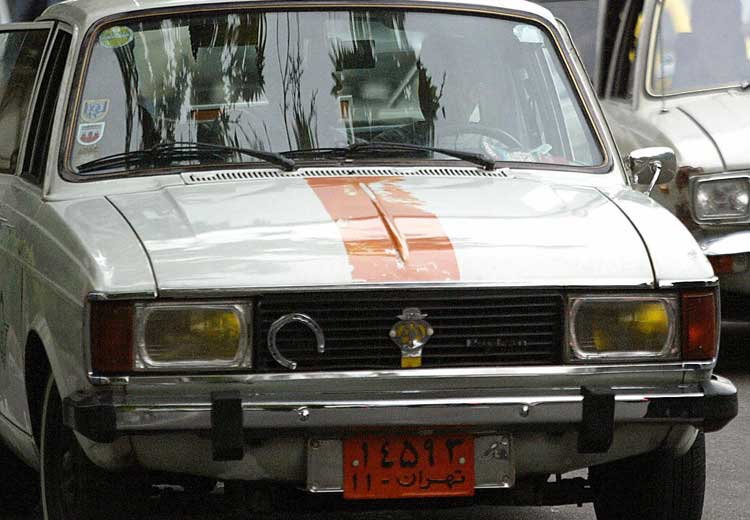Paykan
Andrew Roberts looks at how the Hillman Hunter was reborn as Iran's infamous deathtrap taxi

The English-language brochure of the Paykan contains the well-meaning instruction to "banish fatigue in the well-padded luxury of a Paykan" but when yet another 1966 Rootes Group relic decides to aim itself broadside at your taxi in the midst of an Iranian rush hour, it isn't really very practical.
The average Paykan taxi tends to lack air conditioning, but as they often appear to be devoid of indicators and brakes, this could well be a momentary discomfort. However, for a Briton, just staring through the Paykan's quarterlight windows at a haze of blue smoke lends downtown Tehran an eerie echo of British suburbia circa 1973.
At the time of its demise earlier this year, the Paykan was not the only legacy of Sixties car design produced in the 21st-century; in other parts of the globe, a mere 1,375,000 Kenya shillings could buy a new 504 from Peugeot of Kenya, while fortunate Romanians can purchase the Dacia four-door Pickup (a 1969 Renault 12), and Cairo motorists are offered the splendid Al Nasser (the Fiat 131 Miafiori).
However, the idea of a British car design being manufactured by a foreign concern now belongs to a remote era. On its debut in the UK in 1966, the Hillman Hunter was a perfectly agreeable medium-sized saloon that never seemed to achieve the same affection with the British public as its Mk 2 Cortina rival. Maybe this is due to the fact that it lacked the Ford's association with Michael Caine, from Billion Dollar Brain and Get Carter, but the fact that it was offered with no fewer than five different marque names cannot have helped.
The final T-registered "Chrysler Hunters" left the showrooms just before the Peugeot takeover, and in the normal order of British motoring they would have quickly joined the ranks of forgettable family saloons, but every so often car magazines carried pictures of the continued existence of the Hunter in Iran and no TV footage of Tehran would have been complete without a flotilla of Hillman Hunters gently wrecking the environment during a traffic jam.
By this year, the Paykan, together with the infamous Hindustan Ambassador, was one of the last legacies of the British motor industry as a world force. In 1965, the Rootes Group began Iranian assembly of the Singer Vogue, but the following year saw the launch of the Paykan, to be assembled by the Iran Khodro Motor Works. The Shah was so proud of his national car that when various powers were toadying to Nicolae Ceausescu in the mid-Seventies with offerings of Rolls-Royces and Buicks, the Iranian government's gift took the form of a top-of-the-range Paykan (complete with a vinyl roof) - and many Romanian citizens said that their president truly deserved it.
The Paykan also represented a rare victory for the Rootes Group in the midst of Hillman Imp warranty claims, and even as the company mutated into Talbot and the Paykan continued unabated, latterly with Peugeot mechanics and a truly dire reputation for pollution. One reason behind its survival from an execution announcement from the mid-Eighties onwards was its cheapness - at an asking price of £4,200, the Paykan was eminently accessible to Tehran's army of part-time taxi drivers, many of whom are believed to go "lead happy" after only two years in the job. Aside from the pollution, recent figures from Iran suggest that one person is killed every 28 minutes in a traffic accident. The Paykan's 2005 English brochure does promises such notable safety features as "hydraulic disc front brakes" and "dipping interior rear view mirror" but these are of little value when a Paykan taxi routinely carries 10 passengers plus assorted livestock.
The infamous headline from 1973: "27 passengers killed in 2-Paykan crash" was not at all exceptional, although it is best not to think of it when travelling at 80mph towards a very large and very stationary Hino lorry.
Only one Paykan exists in the UK, a 1982 model that was returned to Coventry for brake adjustments; it is owned by Hillman expert Andy McAdam. His sole complaint is that the bodywork "isn't quite up to 1970s British Leyland standards", which is a diplomatic way of saying that his car has the build quality of cardboard, with the added feature of headlamps that regularly fall out of their sockets.
It resembles a standard LHD Hunter fitted with a 1,600cc Avenger engine and Chrysler Sunbeam S instruments, including a superfluous rev counter; but this is the sole British example of a car that is still regarded as bringing mobility to Iran and, thanks to a thriving spares operation, is likely to be a regular feature of Tehran for the next decade.
Over its 38-year career, it may have also inspired several thousand jokes (What do you call two Paykans at the top of a hill? A mirage) but the Paykan remains a legacy of a time when a car could be proudly sold as "a happy mixture of classic grandeur and modern sophistication". It was an encouraging image for any patriotic Briton taking his first ride in a Paykan taxi, and it lasted just until the moment when the driver slammed his door and the rear nearside wing fell off into the traffic.
Subscribe to Independent Premium to bookmark this article
Want to bookmark your favourite articles and stories to read or reference later? Start your Independent Premium subscription today.

Join our commenting forum
Join thought-provoking conversations, follow other Independent readers and see their replies